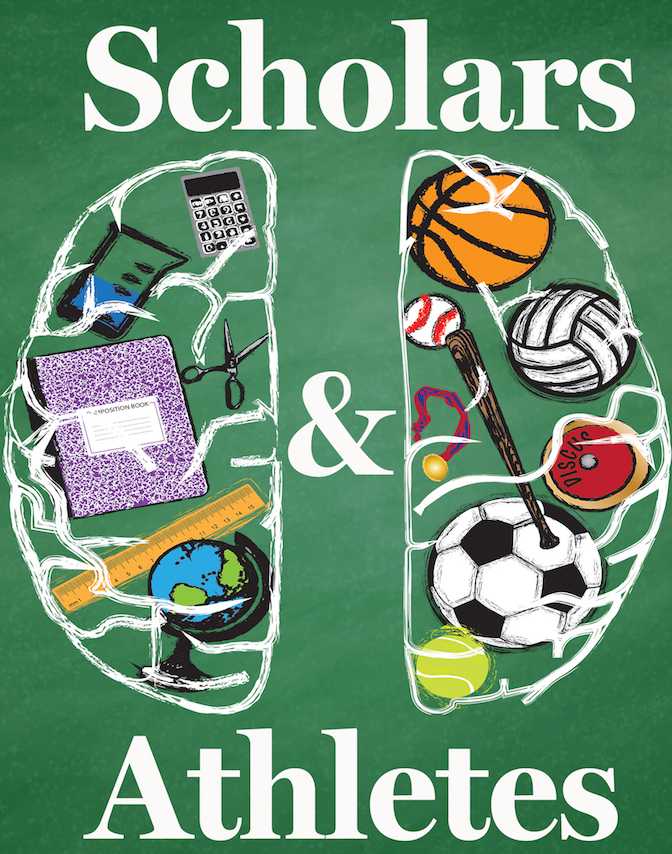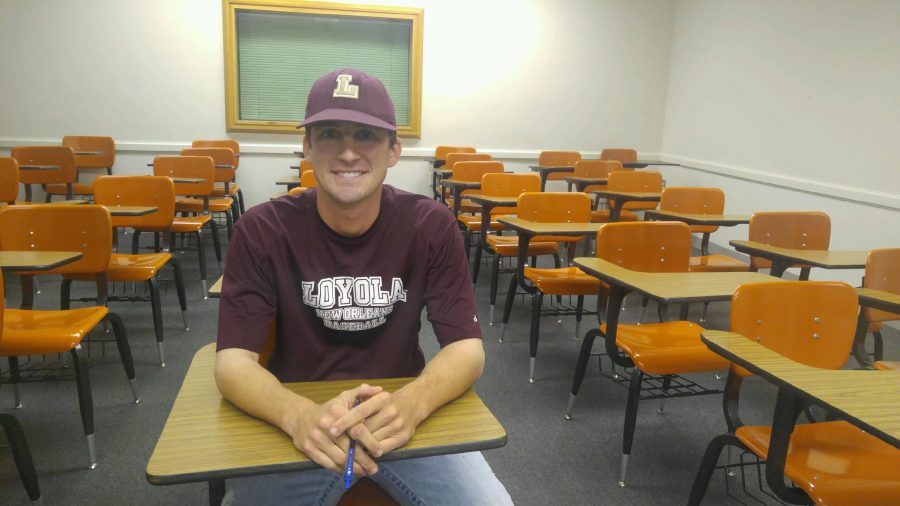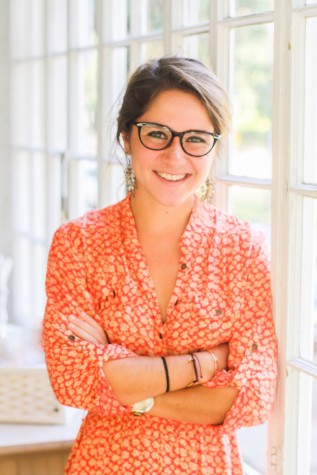Scholars and Athletes
Pre-season conditioning, daily practice, weekly games and conferences, late nights, missed classes, rare free time, high expectations, consistent school work — with only 24 hours in a day, life as a student-athlete is not for the faint of heart
April 29, 2016
He was injured and insulted, but he was too infatuated to allow anything to keep him away from the game he loved.
Even when sleep was low and classwork was piling up, he was practicing his pitch on the diamond.
However, his love of the game was still met with obstacles at every base.
“My adviser once asked me, ‘Why don’t you just give up baseball, so you do not have to worry about your GPA slipping, and ultimately give you more time to focus on your courses,’” said Dylan Gregoire, biology senior, pitcher for the baseball team and 2015 Southern States Athletic Conference All-Academic
Team honoree.
But he didn’t quit. He worked as hard in the classroom as he did on the field, just like the 122 student-athletes with a grade point average of 3.0 or higher who were honored during the 12th annual scholar-athlete awards gala for their skills in the classroom. In addition, throughout the season, athletes who have a GPA of 3.25 or higher are often honored by the SSAC All-Academic Team, and those with a 3.5 GPA or higher are recognized with Daktronics’ Scholar-Athlete award.
According to Brett Simpson, director of athletics, the athletic department looks for students who excel at being a student as much as they do at being an athlete.
“We are committed to recruiting student athletes who will first succeed in the classroom and then contribute in their respective athletic arenas. While the NAIA does set eligibility requirements, it is our standard to far exceed those minimum requirements,” Simpson said.
Professors such as Mark Fernandez, professor of history, notice the special quality of athlete that Loyola recruits.
“In general, a small number conform to the stereotypes; however, the overwhelming majority of our student-athletes shatter the stereotypes,” Fernandez said. “Most are diligent, hardworking students who seem to be here to get an education first and play sports second. Perhaps that’s because we’re not NCAA Division I and we know it.”
The fact that Loyola is not a NCAA school but instead NAIA could be what sets Loyola athletes apart from the norm.
Eddie Comeaux, associate professor of higher education at the University of California Riverside and active researcher of college athletes, said that athletes, especially in Division I schools, develop an athletic complex that can be a detriment to their education.
“There is this idea, even in my own work, in which athletes are perceived by other students and faculty as anti-intellectual, lacking motivation, as one who has this unearned sense of entitlement where they receive extra benefits and perks that are not provided to other students on campus,” Comeaux said. “Students actually come in with these stigmas attached, so I certainly see a disadvantage to athletes in being in a college setting because too often the perception is that they’re not interested in their education.”
However, Kendra Reed, associate professor of management, argues that Loyola students fit the athlete stereotype, but not in the way people often think.
“Athletes strive to be in the best possible physical, mental and spiritual shape in order to go for the ‘win,’ and I think that stereotype translates positively to the classroom,” Reed said. “I hope that more faculty and staff take the time to see our student-athletes’ talents on the playing field because these students embody the “pursuit of excellence” as a whole person and Jesuit ambassadors.”
While Reed has a positive relationship with her students, other athletes such as Briana Olgesby, psychology senior, guard for the women’s basketball team and 2016 SSAC All-Academic Team honoree, sometimes find it difficult to make their schedule work with their professors.
“Professors expect the same from you as any other student. Some are understanding about your extracurricular activities and others aren’t when it comes to absences, make up tests, etc. I tend to stay away from those who I know aren’t willing to work with me around my schedule,” Olgesby said.
For Sam Kohnke, English writing junior, guard for the men’s basketball team and 2015-2016 SSAC All-Academic Team honoree, while basketball is worth every obstacle, he said juggling responsibilities can be taxing.
“Being a student-athlete means you have a limited amount of time to get all of your stuff done. Often times you have to sacrifice sleep and relaxation time in order to maintain success in both academics and athletics,” Kohnke said.
Olgesby agreed that dedication and time management is the best way to get through the week with spare time
to relax.
“You have to be motivated because practice is tiring and going from practice straight to classes all day can wear your body out, but it’s important to find time in the day that you can relax and get your work done,” Olgesby said.
Because the athletic teams work as a unit and have similar mindsets, Alexis Hazard, biology junior, golfer and 2015 SSAC All-Academic Team honoree, said that the golf team keeps each other accountable.
“We are called student-athletes, which means academics always comes first,” Hazard said. “My coach has high expectations of us because he knows we all have the ability to be the best. We have to fill out study hour sheets each week and if needed have team study groups. We are a team, so if one of us is not doing well, we all need to help.”
Even though red-shirted for his final season because of injuries, when comparing Loyola to other schools, Gregoire, who transferred from a junior college, said that coaches at Loyola expect the same quality on the field as in the classroom.
“In my junior college years, I found a certain coach to say, ‘Who cares about grades, let’s just worry about winning.’ However, this is not a part of what makes up Coach Faust’s perspective on grades,” Gregoire said. “He pushes us to talk to teachers, getting to know one’s adviser and other faculty members.”
Doug Faust, head baseball coach, said he never wants his students to feel that their main reason for being at Loyola is not about education.
“Our athletes understand why they are at Loyola. They are here to earn a great degree and continue to play college baseball. We make sure that they understand that academics does indeed come first,” Faust said. “If the player cannot handle playing baseball and maintaining his grades at the same time, he will be monitored through study hall and/or tutoring in the Student Success Center. If the player continues to struggle with his grades, we will take baseball away from him.”
Transitioning from high school to collegiate athletics challenged Trent Sims, biology freshman and track and field member, because of the increase in time commitment to the sport, but he appreciates having a coach that will give him the time to focus on his class work.
“In high school, our practices would only be about an hour long and our meets would only require about 30 minutes of travel. In college, our practices are up to three hours long and we travel to places seven hours away,” Sims said. “My coach is adamant about the prosperity of our team’s academic performance. She is completely understanding when it comes to an athlete needing to miss practice for an important class or study session.”
Similar to Sims’ transition to committing to longer hours, Wren Overesch, graphic design junior, outside hitter for the volleyball team and Daktronics Volleyball Scholar-Athlete honoree, said travel time is what affects her academics the most.
“I am usually running to class from practice, or rushing out of class to get to my game. We travel a lot on the volleyball team, as does every sport here at Loyola, and it is not easy attempting to study for tests or write papers on a charter bus for hours on end,” Overesch said.
According to Comeaux, situations like the one Overesch described happen because there are oftentimes not a support system or policy that enforces academics
over athletics.
“It’s not a fair exchange. When athletes enter a campus, there’s this idea or this assumption that you can be a high achiever in the classroom and you can also perform well on the court or the field,” Comeaux said. “When you think of the athletics side that is highly commercialized where there is oftentimes a tremendous amount of travel and we are starting to see more changes in game schedules so that they are playing more games, athletes are missing more classes than ever before over the past decade.”
But despite the long road trips, lack of social flexibility and fear of slacking in classes, Overesch, along with the other student-athletes, said the experience has made the struggles worth it.
“Being a collegiate student-athlete definitely has its perks, but it also has its downfalls. Almost every day I have to make compromises between volleyball and my social life, whether it be missing campus-wide events during the window or missing a night hanging out with friends,” Overesch said. “The one thing I always try to remember is that I can have a social life at any time in my life, whether it be during college or thirty years from now. That’s simply not the case with volleyball.”












